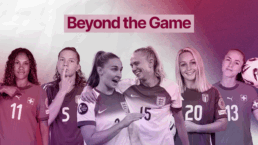The UEFA Women’s Euro 2025 marked a new high point in the continuing rise of women’s sport.
The Women’s Euros drew 657,000 spectators, generated a projected €128 million in revenue – more than double that of Euro 2022 – and became the most engaged Women’s Euro on record across social media. UEFA added over 500,000 new followers across their social media channels; BBC Sport reached 231 million video views during the competition.
These numbers reflect more than just the growth of the game. They speak to the increasing visibility and popularity of players and how they’ve built cultural relevance both on and off the pitch.
It wasn’t big-budget campaigns that fans connected with, it was with content that felt personal, informal and genuine. In women’s sport, where the community is smaller and the relationship between athletes and fans is closer, that tone matters.
This trend was especially clear in the way players used social media throughout the Women’s Euros, shaping narratives that blended identity, emotion and community.
At Redtorch, through SportOnSocial we analysed 2,500+ Instagram and TikTok posts from players representing England, Italy, Germany, Spain, Switzerland and Sweden (alongside team accounts) to understand what of content types truly cut through.
We identified three clear themes that consistently resonated with audiences. Together, they offer useful direction for sponsors looking to engage more meaningfully with sports audiences.
1. Motivational messaging rooted in cultural identity
One of the most effective ways players connected with fans was through motivational messaging that felt distinctly local.
These weren’t packaged slogans or hollow soundbites. They were short, powerful phrases grounded in national idioms, football culture and shared emotional references. In Italy, for instance, players used phrases like “si lotta, si sogna, si crede” – a rallying cry that speaks to hope, belief and the fight ahead.
This wouldn’t have worked as effectively coming from an English player, and that is the point, as the translation isn’t a common expression within the English language.
These expressions were native in feeling as well as language. They reflected how people in each country talk about football, winning and all things related to sport.
What this means for sponsors
Brands looking to align with identity, pride or purpose should pay close attention to how language works within different cultures.
Authenticity isn’t about translating the message; it’s about speaking in a way that feels inherent to the audience. That often means less polish, more instinct, and trusting athletes to lead the tone.
Example
Nike’s SCARY GOOD campaign offers a few examples of a sponsor pulling on various references within football culture, cleverly attaching them to players in a dialect that makes sense to their specific audience.
For example, Have you been skinned by Cole Palmer? , a term highly relevant to British football culture. Brazil’s Vini Jr plays on the term ‘O Tremor, on the other hand, targets a Latin cultural fan base.
2. Content that turns fans into teammates
Another clear cultural signal was the visibility of team rituals: those small behaviours and in-jokes that fans quickly recognised and adopted.
Shared moments within the England squad, for example, featured finger snaps and tactical note references between players, provide a glimpse into the internal lexicon of the squad and its culture. This content was casual, unfiltered and never over-explained because fans didn’t need full context to feel part of something.
By posting these details, players created emotional access. They have invited the audience into their world and acknowledged their presence, building bonds between the players and fans. This familiarity creates a community, and this is what any sponsor should be striving for.
What this means for sponsors
Sponsors need to look for the moments that already hold meaning for players and fans, and then amplify them with care.
If a gesture, tradition or habit is gaining traction organically, it’s a strong signal of community connection. The brand opportunity is to support and share it, not repackage it into something unrecognisable.
Example
Heineken’s recent superstitions campaign is a great case of playing into football fan culture – amplifying its sometimes intense relationship with superstition.
While the theme itself isn’t new, Heineken kept it fresh by adapting it to current football affairs. For example, this promo for the recent men’s UEFA Champions League final works because it feels rooted in real fan behaviours.
3. Celebrating identity through personal journeys and realised dreams
We consistently saw how players used their platforms to reflect on the Women’s Euros as part of a larger personal journey.
Instead of focusing on outcomes and performance alone, many players used their posts to mark what the moment meant to them, emotionally, personally and sometimes culturally. Whether it was a first tournament appearance, a return from injury, or the chance to wear their national shirt again, many players used the Euros to pause and take stock.
Some, like members of the Swiss squad, shared memories of their childhood and the pride of representing their country at home. Posts referenced family, dreams, joy, anguish and how far they’d come on their footballing journey.
Such posts carried emotional weight because they were distinctive. Not simply about football, but intimate and vulnerable player revelations regarding identity and legacy, deepening their bond with the fans.
What this means for sponsors
This kind of content reminds us that major events are about recognition as well as results. Sponsors can support these reflective moments to build trust, relevance and emotional connection. There’s real value in backing longer-term stories, too, especially when they’re told in the athlete’s own voice, at their own pace.
Example
The Athletes Get It campaign by Beats by Dre amplifies athlete stories to spotlight their personal experiences and cultural identities, helping fans connect with who they are beyond sport.
Final Thoughts
The Women’s Euros showed us what good digital engagement looks like in 2025: athlete-led, emotionally intelligent and culturally grounded.
Sponsors don’t need to create new formats or louder content. They need to listen to how athletes are already building connection and to lean into these insights, this will build meaningful engagement for a brand’s own strategies.
Learnings for sponsors
1. Build campaigns in the language of your audience
Craft messaging that feels rooted in local culture, not overly polished or generic. When working across regions, reflect how fans and players naturally speak. This helps campaigns feel more familiar and relevant, especially when tone is shaped by athlete voices or community-led phrasing.
While this approach can feel risky for sponsors – because being specific can seem like you’re narrowing your reach – it often leads to greater impact. By targeting with added intent and a clear position, you’re more likely to reach an audience your message genuinely resonates with. The result is deeper connections and stronger cut-through than broad, generic campaigns typically achieve.
2. Tap into behaviours that already have meaning
Spot team rituals, phrases or habits gaining attention organically and use them as starting points. Don’t try to force or reinvent them. Supporting what’s already resonating is often more effective than creating something new from scratch.
3. Recognise the role of narratives in building connection
Some of the most powerful posts from the Women’s Euros didn’t focus on results – they were about what the moment meant. Sponsors should consider how campaigns can create space for reflection and storytelling. Showing what something means can often land harder than what has happened.
4. Stay close to culture shifts
Athletes often pick up on trends, tones and signals before brands do. Pay attention to how they share, what they reference, and how fans respond provides sponsors with a useful guide for tone and direction. It’s not about copying – it’s about staying aligned with how sport is evolving in real time.
Women’s sport is currently a smaller, more connected community where fans and athletes value authenticity over scale, and where informal, human communication builds more trust than polished campaigns ever could. Understand this and act on it if you want to really stand out.
Enjoyed reading about the Women’s Euros? Check out our She Moves The Game hub, for more content on women’s sport!





